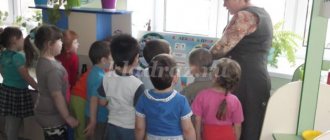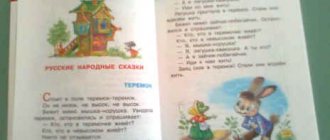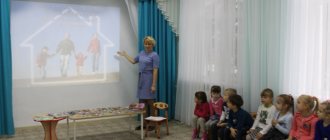Project “Children's Book Week “Book, I Love You!”
Minibaeva O.S. Project “Children's Book Week “Book, I Love You!” // Owl. 2020. N4 (14). URL: https://kssovushka.ru/zhurnal/14/ (date of access: 10.10.2020).
Order No. 121356
Type of project: cognitive-creative, speech
Project participants: children of all age groups, parents, teachers
Project type: short-term
Implementation time: 1 week
Relevance
The main task of introducing preschool children to fiction is to cultivate interest and love for the book, the desire to communicate with it, the ability to listen and understand literary text. S. Marshak said that there is a writer’s talent, and there is a reader’s talent. Like any talent (it is hidden in everyone, it must be discovered, nurtured and educated). A child accustomed to a book has the invaluable gift of easily entering into the content of what he hears or read and living it. The book introduces the child to the world of human feelings of joy, suffering, relationships, motives, thoughts, actions, characters. The book reveals human and spiritual values. A book read in childhood leaves a stronger impression than a book read in adulthood. The task of an adult is to reveal to a child the miracle that a book contains, the pleasure that immersion in reading brings. The process of communication between a preschooler and a book is the process of developing his personality. A preschool child is a kind of reader. He perceives literature by ear, and this continues until he himself learns to read. Today, in a changing socio-cultural situation, preschool institutions are more acutely faced with the problem of developing children’s interest in books than ever before. Today's children are moving away from books, preferring TV and computers. It is impossible to instill in a child a love of literature if the adult is irresponsible in choosing books to read. The problem is aggravated by the fact that a child who is indifferent to books lacks motivation for subsequent learning to read, which means difficulties arise in school. Today, the relevance of solving this problem is obvious, because reading is associated not only with literacy and education. It forms ideals, broadens one’s horizons, and enriches a person’s inner world. That is why we chose a project that would give children an idea of the creation of books and their diversity.
Goal: Fostering love and respect for books. Forming children's interest in children's books through creative and cognitive activities.
Tasks:
Children: - introducing preschool children to fiction, developing an interest in books and children's reading, acquiring a stock of literary artistic impressions, listener experience; - nurturing a value attitude towards a book as a work of art; - deepening children's individual literary preferences, aesthetic taste; - formation of the personal position of preschoolers, both in the perception of literary works and in the process of creativity; - development of cognitive, creative and emotional activity in the process of introducing preschoolers to literature; - broadening the horizons of children, enriching and activating vocabulary (cover, binding, illustration, printing , font, manuscript, parchment, papyrus, birch bark, encyclopedia, dictionary, etc.); - nurturing in children the skills of cooperation with peers and adults in the process of joint activities; - nurturing the desire for constant communication with the book and caring for it.
Parents:
- introduction of various methods of working with books into the practice of family education; - involving parents in creating conditions for the development of children’s interest in books at home and in kindergarten; - increasing parental competence in the process of children’s reading.
Teachers:
- increasing the professional level of teachers on organizing work with books and literary works; - activating the creative potential of teachers; - developing teaching materials “Work in the book corner” (card file of games, methods and techniques for working with literary works, notes for classes, leisure and other events ); - introduction into pedagogical practice of various forms and methods of working with literary works for the development of children’s cognitive, creative and emotional activity (the use of aids and materials available in kindergarten to facilitate children’s familiarization with books for the development of children’s cognitive, creative and emotional activity).
Project stages:
Preparatory: - problem statement, definition of goals and objectives; -selection of material for decorating exhibitions in the book corner: books of different textures, orientations, portraits of children's writers and graphic designers, illustrations for works of art; — preparation of attributes for theatrical activities and material for artistic and creative activities; - reading fiction of various types to children in accordance with age characteristics; memorizing poems; — development of presentations for conducting conversations with children on the topics of children’s book week
Main: Organizing and conducting project events through joint activities with children, organized during special moments, through the integration of educational areas and types of children's activities
Final: Product of activity: Campaign “Books from older to kids”; a gift from children of primary and secondary groups to children of senior and preparatory groups “Bookmarks for books”; "Signs for handling books."
Project methods: - gaming: didactic games; Board games; outdoor games; games - dramatization; plot - role-playing games; - verbal: reading and telling poems, fairy tales, riddles; conversation, conversation; looking at pictures; looking at books; encyclopedias; - practical: exercises (providing assistance), joint actions of the teacher and the child; - visual: showing presentations, using illustrations, paintings, thematic exhibitions.
Junior preschool age
Monday “Book Story”
Goal: to expand the concept of Book in children
- A surprise moment: the children are greeted by a book and have a conversation about the questions: “Are there many books in your home? Who reads to you at home? Why is it needed, how should it be handled”
- Didactic game “Assemble a picture” Purpose: to teach how to assemble a picture from parts and name characters from familiar works of art: fairy tales, short stories, Russian folklore; develop imagination,
- Reading nursery rhymes with a presentation of “The Cockerel”, “The White-sided Magpie”, etc. Purpose: to introduce children to Russian nursery rhymes, to promote active pronunciation of the words of the nursery rhyme when the teacher reads it, to make them want to listen to the nursery rhyme again.
- Finger gymnastics “The cockerel woke up” Purpose: to develop hand motor skills, learn to correlate text with movements
- Artistic and creative activity: application “Bookmark for a book as a gift for children of older groups” Purpose: to introduce children to why a book needs a bookmark, learn to stick different shapes on a strip of paper, develop aesthetic perception.
- Looking at illustrations in books Goal: to continue to teach children to look at their favorite books and illustrations, to teach them to enjoy meeting a book and familiar characters; consolidate the ability to convey your impressions to peers.
Tuesday “Visiting a fairy tale”
Goal: Consolidating and systematizing children’s knowledge about fairy tales.
- Consideration of the exhibition of books “Russian folk tales” Purpose: to encourage children to show interest in books.
- Didactic game “Guess the fairy tale from the illustration” Purpose: to consolidate knowledge of the names of fairy tales
- Outdoor game: “The little white bunny is sitting” Goal. To teach children to listen to the text and perform movements in accordance with the text; teach them to jump, clap their hands, and run away after hearing the last words of the text.
- Theatrical game “Box of Fairy Tales” Purpose: to recall familiar fairy tales with children, to encourage children to become heroes; activate the tabletop theater in the game; arouse children's interest in theatrical activities.
- Finger gymnastics “Favorite fairy tales” Purpose: to develop fine motor skills, consolidate the names of fairy tale characters
- Artistic and creative activity: drawing “Kolobok - ruddy side” Purpose: to consolidate the ability to draw a circle with paints, develop interest in fairy tales, cultivate accuracy. Teach children to draw based on folk tales.
- Reading a fairy tale of the children's choice. Goal: to develop interest in books, the ability to listen to fairy tales and engage in conversation based on what they read. Follow the development of the action and empathize with the characters of the work.
Wednesday “Writers for Children”
Goal: expand and generalize children’s knowledge about children’s writers and their works
- Examination of portraits of children's writers Purpose: to introduce children to the images of children's writers and their works
- Didactic game “Place the heroes in their places” Goal: to develop thinking abilities, the ability to distinguish between characters belonging to a particular literary work.
- Reading Ch. Yancharsky “Friends” Purpose: to teach children to listen carefully to works of art, to develop moral qualities.
- Dynamic pause “Friendly guys” Goal: to develop children’s motor activity, cultivate friendliness
- Artistic and creative activity: modeling “Treat for the heroes of the story “Friends” Goal: continue to learn how to sculpt an oval and a circle, develop fine motor skills of the hands; develop a desire to help others
Thursday “Kaleidoscope of Poems”
Goal: to instill interest in children in poetic works
- Game situation “Guess who I am?” Goal: introduce children to a play situation; develop the ability to find an object (toy), focusing on its signs and actions
- Reading poems about nature, animals with a presentation. Purpose: to teach carefully, listen to poems, cultivate an emotional attitude towards the world around us through fiction (poetry)
- Outdoor game “The little white bunny is sitting” Purpose: to teach children to listen to the text and perform movements from the texts, practice jumping and running; bring joy to children
- Offer children coloring pages “Spring has come” (flowers, trees, animals, etc.) Goal: develop the ability to select the right colors, consolidate the ability to not go beyond the outline when coloring
Friday “A book is a secret, a book is a treasure, a book is a friend for all children!”
Goal: to cultivate a desire for constant communication with the book and caring for it.
- Examination of books at the exhibition “Fun Books” (books of unusual design: sound, clamshell, three-dimensional, with moving parts, etc.)
- Theatrical activity: “How a book was offended” Goal: to continue to develop in children a caring attitude towards books, to evoke a positive emotional response
- Didactic game “Give me a word” Purpose: to train children in the correct selection of words from familiar fairy tales, to develop auditory perception.
- Low mobility game “Find a Pair” Goal: to develop classification and sorting skills, hand-eye coordination, hand motor skills, thinking skills, and consolidate knowledge of works of art.
- Role-playing game “Bookstore” Purpose: to give children knowledge that books are sold in the store; form the simplest forms of role interaction; consolidate the idea of the profession “Seller”.
Work with parents: consultations “The role of books in a child’s life”, “So that fairy tales do not become boring”, “Introducing children to reading”; recommendations “Organizing a book corner and reading in the family”, “Theater on the kitchen table”; booklet “Book or TV”; folder “What books are recommended for children to read?”
Middle preschool age
Monday “Book Story”
Purpose: to introduce children to the history of the book
- Conversation with a presentation “A Journey into the Past of Books, What Kinds of Books There Are” Goal: to introduce children to the history of the development of books, with their diversity, to cultivate a desire for constant communication with books
- Artistic and productive activity: application “Bookmarks for books” Purpose: to expand children’s knowledge about the rules of handling books, to teach how to cut a circle and a triangle from a square, to strengthen the ability to stick figures on a strip of paper, to cultivate accuracy and caution when using scissors.
- Didactic game “Guess from the illustration” Purpose: to develop logical thinking, teach to guess the book (author and title from the illustration)
- Reading the fairy tale by L. Potsepun “The Story of a Book” Purpose: to introduce children to the rules for handling books; develop interest in reading books
- Excursion to the virtual library “House of Books” (presentation) to introduce children to the library, its meaning, and visiting rules.
Tuesday “Visiting a fairy tale”
Goal: to consolidate and systematize children’s knowledge about fairy tales.
- Game exercise “Journey to a Fairy Tale” Purpose: to raise the muscle and emotional tone of children; develop imagination and plastic expressiveness.
- Conversation “The fairy tale begins from the beginning, is read to the end, without interruption in the middle” Goal: to clarify and consolidate the understanding of the “fairy tale” as a work and as a term; to promote the formation of active listening from beginning to end without interrupting; contribute to the development of respect for the narrator, the speaker.
- Educational game “Collect a picture” (for a fairy tale) Purpose: to promote the development of thinking, attention, and the ability to complete a task started.
- Dramatization of the Russian folk tale “Teremok” Purpose: to train children in telling fairy tales with characters, to consolidate the ability to pronounce the endings of words, and to develop children’s speech.
- Construction games with a variety of construction sets “Hut on Chicken Legs” - strengthen the ability to distinguish and name building parts, use them taking into account their structural properties (stability, size, shape).
- Russian folk outdoor game “Rooks” Purpose: to develop coordination of movements, motor activity; cultivate a desire to play folk games
- Quiz “Chest of Fairy Tales” Purpose: to remember familiar fairy tales and fairy-tale characters, develop attention, speech activity, cultivate interest in fairy tales
Wednesday “Writers for Children”
Goal: to expand children’s knowledge about author’s literary works, to continue to introduce preschoolers to the works of children’s writers.
- Examining portraits of children's writers and talking about them Goal: to expand and generalize children's knowledge about children's writers in Russia and introduce them to writers from other countries; develop curiosity, attention, memory; to cultivate a love of reading and interest in studying the works of different writers from around the world.
- Didactic game “Recognize the hero by description” Goal: remember poems and riddles about animals, develop thinking and speech.
- Artistic and creative activity: drawing “My Favorite Hero” Purpose: to learn to convey in drawing the characteristic features of a favorite character in works of art, to cultivate interest in literature.
- Reading “The Living Hat” by N. Nosov Goal: to form ideas about moral standards with the help of children's literature.
Thursday “Kaleidoscope of Poems”
Goal: to instill interest in children in poetic works
- Didactic game “Rhymes” Purpose: to teach children to select rhyming words
- Artistic and creative activity: offer coloring books on the theme “Nature in verse” Goal: to help improve the ability to color without going beyond the outline, in one direction; develop fine motor skills of the fingers; consolidate knowledge of the main colors of the spectrum; develop creativity.
- Reading competition “And I know it by heart” Goal: to give children joy from the competition, to remember poems by children’s poets, to develop the ability to listen to a friend.
- Game situation “The book is sick” Goal: to develop a caring attitude towards books, to develop practical skills in repairing books; cultivate empathy.
Friday “A book is a secret, a book is a treasure, a book is a friend for all children!”
Goal: to cultivate a desire for constant communication with the book and caring for it.
- Problem situation: “What would happen if all the books disappeared” Goal: to develop the ability to solve problem situations, thinking, speech activity; discuss the importance and significance of books in a person’s life
- Reading proverbs and sayings about books Goal: continue to form the concept of the significance of a book, teach to see the hidden meaning in proverbs
- Artistic and creative activity: “Rules for handling a book” (making badges for the book corner) Purpose: repeat the rules for using books, create interest in the book, reinforce the rules for working with scissors and other materials; develop creativity and imagination
- Literary quiz “Through the pages of your favorite books” Purpose: to increase interest in literature; systematize and generalize children’s knowledge of familiar works of art; to form a desire for constant communication with a book, a desire to learn to read, develop the ability to analyze, compare
- Role-playing game: “Bookstore” Goal: to shape the social experience of children through play activities, to continue to teach children to distribute roles and act according to the role they have assumed, to develop the plot, to develop dialogic and monologue speech, and the imagination of children; cultivate a friendly attitude towards the work of an adult, respect for books
Work with parents: consultations “The role of books in a child’s life”, “So that fairy tales do not become boring”, “Introducing children to reading”; recommendations “Organizing a book corner and reading in the family”, “Theater on the kitchen table”; booklet “Book or TV”; folder “What books are recommended for children to read?” Invite parents to make a “Baby Book” together with their children.
Senior preschool age
Monday “Book Story”
Purpose: to introduce children to the history of the book
- Conversation with a presentation “Journey to the Book’s Past” Purpose: to introduce children to the history of the creation of the book; show its significance in a person’s life. Bring children, at a level accessible to them, to the understanding that books are the main source of knowledge
- Didactic game “Correct the mistake” Purpose: teaches children to listen and look carefully, detect and correct mistakes
- Artistically creative activity: “Making paper with our own hands” Purpose: to consolidate knowledge about some properties of paper, to promote interest in independent creative activity; develop the ability to work together for a common cause; expand children's horizons; cultivate neatness.
- Reading “The Tale of Books” by E. Tvorogov Goal: to introduce children to the meaning of books, to cultivate a desire to treat books with care
- Excursion to the virtual library “House of Books” (presentation) Purpose: to introduce children to the library, its meaning, rules of visiting, to develop knowledge that books are different (encyclopedias, magazines, fables, author’s fairy tales).
Tuesday “Visiting a fairy tale”
Goal : consolidate and systematize children’s knowledge about fairy tales.
- Conversation “What do fairy tales teach?”, “Heroes of fairy tales - what are they?” Purpose: to generalize and consolidate children’s knowledge about fairy tales; teach to name the distinctive features of heroes, naming their positive and negative qualities; develop observation and memory; cultivate a love for Russian folk art
- Didactic games: “Which fairy tale is the hero from?”, “Guess the hero” Purpose: to reinforce with children the names and characters of familiar fairy tales, creative imagination, motor activity
- Russian folk outdoor game “Burn Clear” Purpose: to develop coordination of movements, motor activity; cultivate a desire to play folk games
- Theatrical activity: acting out mini-scenes based on favorite fairy tales Goal: development of artistic abilities, emotionality, through playing the role of a hero
- Literary reading to choose from: “The Snow Maiden”, “Ivan Tsarevich and the Gray Wolf”, “Underground Kingdoms”.
Wednesday “Writers for Children”
Goal: to expand children’s knowledge about author’s literary works, to continue to introduce preschoolers to the works of children’s writers
- Examination of portraits of children's writers and conversation with them Goal: to expand and generalize children's knowledge about children's writers in Russia and introduce them to writers from other countries; develop curiosity, attention, memory; to cultivate a love of reading and interest in studying the works of different writers from around the world.
- Didactic game “Guess whose object” Goal: to develop attention, memory, speech activity; learn to correlate the subject and hero of familiar works
- Reading V. Dragunsky “Childhood Friend” Goal: to cultivate attentiveness, love and compassion for one’s neighbor, to form a sustainable interest in reading works of fiction
- Game “Complete the Hero” Purpose: to develop imagination, memory, drawing skills
- Role-playing game “In the Library” Purpose: to broaden the horizons of children, to systematize children’s knowledge about the profession of a librarian, about the content and significance of his work; develop gaming skills, a friendly attitude towards peers, the ability to interact and negotiate; develop independence and initiative; cultivate a caring attitude towards books
Thursday “Kaleidoscope of Poems”
Goal: to instill interest in children in poetic works
- Conversation with showing the presentation “Acquaintance with artists - illustrators” Purpose: to introduce children to artists - illustrators of children's books (Yu.A. Vasnetsov, E. and N. Charushins); to form an aesthetic attitude to the surrounding world, emotional responsiveness to works of art; develop speech activity, the ability to enter into dialogue; cultivate a caring attitude towards the book, a desire to constantly communicate with it
- Didactic game “About whom?” What is it about? Purpose: to teach to analyze the structure of a poem, to develop a sense of rhythm and rhyme
- Reading competition “Young Poetry Admirers” Goal: to develop expressive speech in preschoolers through artistically poetic words, to cultivate a positive emotional attitude towards literary poetic works;
- Manual labor “Book Hospital” Goal: to develop a caring attitude towards books, to develop practical skills in repairing books; cultivate empathy.
Friday “A book is a secret, a book is a treasure, a book is a friend for all children!”
Goal: to cultivate a desire for constant communication with the book and caring for it.
- Problem situation “What would happen if all the books disappeared?” Goal: develop the ability to solve problem situations, thinking, speech activity; discuss the importance and significance of books in a person’s life
- Reading proverbs and sayings about books Goal: continue to form the concept of the significance of a book, teach to see the hidden meaning in proverbs
- Promotion “Books from older children to children”. Goal: to promote caring for children, to instill a desire to please other people, to form a sustainable interest in literature
- Artistic and creative activity: “Rules for handling a book” (making badges for the book corner) Purpose: repeat the rules for using books, create interest in the book, reinforce the rules for working with scissors and other materials; develop creativity and imagination
- Literary quiz “Through the pages of your favorite books” Purpose: to increase interest in literature; systematize and generalize children’s knowledge of familiar works of art; to form a desire for constant communication with books, a desire to learn to read, to develop the ability to analyze and compare.
- Role-playing game: “Bookstore” Goal: to shape the social experience of children through play activities, to continue to teach children to distribute roles and act according to the role they have assumed, to develop the plot, to develop dialogic and monologue speech, and the imagination of children; cultivate a friendly attitude towards the work of an adult, respect for books
Work with parents: consultations “The role of books in a child’s life”, “So that fairy tales do not become boring”, “Introducing children to reading”;
recommendations “Organizing a book corner and reading in the family”, “Theater on the kitchen table”; booklet “Book or TV”; folder “What books are recommended for children to read?” Invite parents to make a “Baby Book” together with their children.




